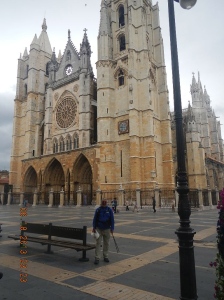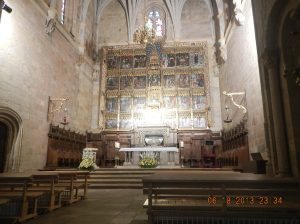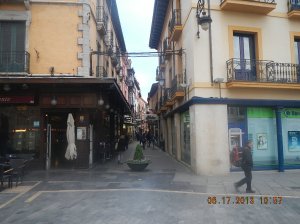Stage 21– León to Villar de Mazarife
Total Distance – 22.2 km + 4.5 km (getting lost) = 26.7 km
Adjusted for Climb – 27.9 km (accrued ascent 250 m = 1.2 km)
High Point: Páramo 901 m (2,956 feet)
CLICK ON THE PICTURES TO ENLARGE TO FULL-SIZE
As I walked along León’s Calle Anche toward La Plaza Regla I reflected on my two days in the city. I had used the inclement weather to my advantage to rest and recuperate. I also had the good fortune to run into the Canadian trio of Rhys (the 10-year-old Peregrino), his father Jamie and his uncle Michael on my first night in town. They were eating dinner in the Bar “La Jouja” on the Plaza Torres de Omaña when I happened to enter it looking for a place to eat. I gladly accepted their offer to join their group of 6 Peregrinos and we had an enjoyable evening eating, drinking and talking about our experiences. They were moving on the next day and I unfortunately would not see them anymore while on the Camino.
Fast forward to my last morning in León, as I was walking on the Calle Ancha I was asked by a group of Canadian women for help in locating their convent/albergue and as I finished giving them directions I heard “Miguel, Miguel!” shouted by Juan, the Mexican Peregrino I had dined with at the monasterio in Sahagún. It was great to be reunited with him and we walked together to the Cathedral where he took my picture before I continued on my way out-of-town. Unfortunately, he was staying another day in town but we enjoyed our brief reunion together.

The picture in La Plaza Regla in front of the cathedral that Juan took of me as I set out that rainy morning.
As I followed those ever-present yellow arrows I was soon at the Plaza de San Isidoro, the cradle of the Kingdom of León. The plaza, which has a Basílica, Pantheon and museum, is named after Isidoro de Sevilla (560 – 636 AD) who was a very important Visigoth scholar-cleric. In addition to building schools and composing missals and breviaries he wrote the Etymologies, the world’s first encyclopedia. The Basílica is built in a Romanesque style of the 11th century and it was constructed from 1056 to 1067 due to the efforts of Fernando I of Castilla and León who was a famous warrior in addition to being a deeply religious monarch. Located here are some of the best in situ Romanesque murals in al of Spain and very possibly all of Europe. The museum contains a large amount of high quality art and the Pantheon de los Reyes is the resting place 23 kings, 12 princes and 9 counts. In the Pantheon you will also see fresco paintings dating from the first third of the 12th century. The themes of the paintings are the childhood, Passion and glorification of Christ with episodes of the childhood and Passion arranged in accordance with the pattern of a Mozarabic mass. The Pantheon because of the great beauty of its frescoes has been called Spain’s Romanesque Sistine Chapel. Did I see any of these wonders? No!! I would have needed at least 2 hours and to my dismay I had to move on.
 Before entering the Basìlica for a quick visit I saw a priest standing amongst a group of three tourists. He was a tall, good-looking man dressed in an old-fashioned long black cassock that buttoned up from the ankles almost all the way up to his neck. A wide-brimmed black hat shaded his face and I thought 20 years ago this young Jesuit would have been a Spaniard but that was not the case now as the handsome Jesuit was clearly an African priest. He was the center of attention in the small group and I very much wanted to ask him for a pilgrim’s blessing but I didn’t dare because I did not want to disturb him or his group so I entered the Basìlica without asking. As I left the Basìlica he and his group were gone and I felt annoyed with myself for not asking for that blessing. Little did I know that I was to have a second chance at a pilgrim’s blessing that day.
Before entering the Basìlica for a quick visit I saw a priest standing amongst a group of three tourists. He was a tall, good-looking man dressed in an old-fashioned long black cassock that buttoned up from the ankles almost all the way up to his neck. A wide-brimmed black hat shaded his face and I thought 20 years ago this young Jesuit would have been a Spaniard but that was not the case now as the handsome Jesuit was clearly an African priest. He was the center of attention in the small group and I very much wanted to ask him for a pilgrim’s blessing but I didn’t dare because I did not want to disturb him or his group so I entered the Basìlica without asking. As I left the Basìlica he and his group were gone and I felt annoyed with myself for not asking for that blessing. Little did I know that I was to have a second chance at a pilgrim’s blessing that day.
My next stop would be León’s Plaza de San Marcos. Here was the magnificent monastery of San Marcos which is now a Parador Nacional 5-Star hotel, church and museum. Originally on this site was an ancient pilgrim hospital that was owned by the Order of Santiago. Fernando el Católico in 1514 decided to raze the ancient structure and build the monastary. The architects he chose for the project were: Juan de Orozco (church), Martín de Villarreal (Facade) y Juan de Badajoz el Mozo (cloister and sacristy). Little did they know that it would take over two centuries to complete the project. In the past this building served as a:
- Headquarters of the Order of the Knights of Santiago
- Prison: Here was jailed the famous Spanish poet Francisco de Quevedo, by order of the Conde-Duque de Olivares for almost 4 years, between 1639 y 1643.
- A Secondary School
- Veterinary School
- Jesuit Mission House.
- Seminary.
- Military Headquarters
- Military Prison
- Government Buildings
- Diócesis.
In 1875 the local government had plans to tear down the building but luckily those plans were shelved. The beauty of the building is self-evident and I’ve seen pictures of it at night that are magnificent. Next trip I will make sure to stay here and enjoy all the beauty that it has to offer.
Just outside the Parador in the Plaza San Marcos is a cross with a weary Peregrino to greet all of the peregrinos walking on to Santiago!

Somethings never change! I’ve seen many Peregrinos resting this way. Notice the scallop shell on his hat.
After a brief stop at the Plaza San Marcos I continued over the 16th century Puente río Bernesga and was soon in the suburbs of the town. It was in the suburbs that I encountered a trio of Irish Peregrinos; Theresa (who I had met while walking to Villalcázar de Sirga), James and Shane. We kept on seeing each other on the route so much that we soon ended up walking together.
After walking for close to an hour we stopped at the Iglesia La Virgen del Camino. The Church is ultra modern (1961) and built on the site of the shrine where a shepherd, in the early 16th Century, saw a vision of the Virgin who told him to throw a stone and then build a church on the spot where it landed. The church has become a pilgrimage site in its’ own right on the account of the miracles performed here. Today it was to be the site of a special blessing.
Each member of our group was sitting or kneeling in the church praying and alone with their thoughts. During this time I noticed that a young Priest was doing some of the work that’s done after the Mass. I immediately went up to him and asked for a blessing for our group.
He took us to the chapel at the back of the church and gave us all a fantastic blessing!!! It was the standard beautiful blessing from 12th Century (in Spanish) that all Pereginos have heard at one time or another, but, he took it to another level by putting his hand on our foreheads and hugging each and every one of us. I truly felt blessed.

Theresa, Shane, the Dominican Priest, James and myself in the chapel where we recieved our special blessing
It turns out the Priest (dressed in a white Dominican habit) spoke a little English because he had lived in Cork, Ireland (where Theresa of our group is from) and he spent time talking to each and every one of us asking about where we were from. We had a very pleasant time chatting but soon had to continue on our way.
My son later emailed me and said that the Priest was, “An Angel in White” and I agree.
Our group was soon out of the suburbs and walking in the open countryside of the páramo (meaning barren plain or moorland) and it was here that two things happened. First we met Isabella a Peregrina from Yorkshire, England. Isabella was in her early twenties and soon joined our group. Unfortunately, it was here right at the intersection of the N-120 and A-66 roads that we ended up taking a massively wrong turn and we were soon off course and in the rain! I still don’t know how we got so far off course but soon we realized that we were going in the wrong direction. Now, with hindsight I know that we actually walked along the A-66 to a path that took us to the Urbanization Jano (a sleepy hamlet of homes). Exactly the opposite way that we needed to go!! Luckily we found a sanitation truck and the driver told us that we had to walk until we saw a road and go to the right. Well his directions eventually got us to almost to the place where we started, the intersection of the N-120 and the A-66! Now I know that we covered about 4.5 km more than we needed too!
The rest of our journey to Villar de Mazarife was a long walk in the cold rain. I remember at one time becoming separated from James and Shane because Theresa, Isabella and I were wet and cold and we decided to quicken the pace. I don’t think I ever walked as fast in my life as I walked that day with those two!! At one point we did a 6 km clip in an hour!! It must have been our adrenalin kicking in because of our desperation to arrive. Whatever it was we made it to Villar de Mazarife in the evening.


































